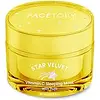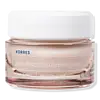What's inside
What's inside
 Key Ingredients
Key Ingredients

 Benefits
Benefits

 Concerns
Concerns

 Ingredients Side-by-side
Ingredients Side-by-side

Water
Skin ConditioningCetearyl Alcohol
EmollientGlycerin
HumectantButylene Glycol
HumectantGlyceryl Stearate
EmollientCetyl Ethylhexanoate
EmollientButyrospermum Parkii Butter
Skin ConditioningPolyglyceryl-3 Methylglucose Distearate
EmulsifyingSimmondsia Chinensis Seed Oil
EmollientDimethicone
EmollientSorbitan Sesquioleate
Emulsifying1,2-Hexanediol
Skin ConditioningSodium Hyaluronate
HumectantHippophae Rhamnoides Fruit Extract
Skin ConditioningBetaine
HumectantHelianthus Annuus Seed Oil
EmollientBeta-Carotene
Skin ConditioningCarbomer
Emulsion StabilisingArginine
MaskingPropanediol
SolventCaprylyl Glycol
EmollientIllicium Verum Fruit Extract
PerfumingXanthan Gum
EmulsifyingPanthenol
Skin ConditioningBeta-Glucan
Skin ConditioningTocopheryl Acetate
AntioxidantCitrus Junos Fruit Extract
Skin ConditioningEthylhexylglycerin
Skin ConditioningCeramide NP
Skin ConditioningGlycosphingolipids
EmollientHydrogenated Lecithin
EmulsifyingSalvia Officinalis Leaf Extract
CleansingChamaecyparis Obtusa Leaf Extract
Skin ConditioningMelissa Officinalis Leaf Extract
Skin ConditioningPinus Densiflora Leaf Extract
AntimicrobialNelumbo Nucifera Leaf Extract
Skin ConditioningAvena Sativa Meal Extract
SoothingOryza Sativa Bran Extract
Skin ConditioningSolanum Lycopersicum Fruit Extract
AntioxidantAscorbic Acid
Antioxidant3-O-Ethyl Ascorbic Acid
Skin ConditioningCitrus Aurantium Dulcis Peel Oil
MaskingWater, Cetearyl Alcohol, Glycerin, Butylene Glycol, Glyceryl Stearate, Cetyl Ethylhexanoate, Butyrospermum Parkii Butter, Polyglyceryl-3 Methylglucose Distearate, Simmondsia Chinensis Seed Oil, Dimethicone, Sorbitan Sesquioleate, 1,2-Hexanediol, Sodium Hyaluronate, Hippophae Rhamnoides Fruit Extract, Betaine, Helianthus Annuus Seed Oil, Beta-Carotene, Carbomer, Arginine, Propanediol, Caprylyl Glycol, Illicium Verum Fruit Extract, Xanthan Gum, Panthenol, Beta-Glucan, Tocopheryl Acetate, Citrus Junos Fruit Extract, Ethylhexylglycerin, Ceramide NP, Glycosphingolipids, Hydrogenated Lecithin, Salvia Officinalis Leaf Extract, Chamaecyparis Obtusa Leaf Extract, Melissa Officinalis Leaf Extract, Pinus Densiflora Leaf Extract, Nelumbo Nucifera Leaf Extract, Avena Sativa Meal Extract, Oryza Sativa Bran Extract, Solanum Lycopersicum Fruit Extract, Ascorbic Acid, 3-O-Ethyl Ascorbic Acid, Citrus Aurantium Dulcis Peel Oil
Water
Skin ConditioningGlycerin
HumectantGlyceryl Stearate Citrate
EmollientDicaprylyl Carbonate
EmollientTriheptanoin
Skin ConditioningAlcohol Denat.
AntimicrobialBehenyl Alcohol
EmollientGlyceryl Stearate
EmollientAloe Barbadensis Leaf Juice
Skin ConditioningIsodecyl Neopentanoate
EmollientSimmondsia Chinensis Seed Oil
EmollientCera Alba
EmollientLecithin
EmollientImperata Cylindrica Root Extract
Skin ConditioningAcacia Decurrens/Jojoba/Sunflower Seed Wax Polyglyceryl-3 Esters
EmollientRosa Canina Fruit Oil
EmollientAcrylates/C10-30 Alkyl Acrylate Crosspolymer
Emulsion StabilisingAscorbyl Tetraisopalmitate
AntioxidantCaprylyl Glycol
EmollientCarbomer
Emulsion StabilisingCetearyl Alcohol
EmollientCitric Acid
BufferingDistarch Phosphate
AbsorbentGalactoarabinan
Glycine Soja Oil
EmollientGlycine Soja Sterols
EmollientHelianthus Annuus Seed Oil
EmollientHydrolyzed Sodium Hyaluronate
Skin ConditioningHydroxyethyl Acrylate/Sodium Acryloyldimethyl Taurate Copolymer
Emulsion StabilisingLactic Acid
BufferingParfum
MaskingPhenoxyethanol
PreservativeRosa Canina Fruit Extract
AstringentRosmarinus Officinalis Leaf Extract
AntimicrobialRosmarinus Officinalis Extract
AntimicrobialSodium Benzoate
MaskingSodium Gluceptate
Sodium Hydroxide
BufferingTetrahydrodiferuloylmethane
AntioxidantTocopherol
AntioxidantTocopheryl Acetate
AntioxidantXanthan Gum
EmulsifyingWater, Glycerin, Glyceryl Stearate Citrate, Dicaprylyl Carbonate, Triheptanoin, Alcohol Denat., Behenyl Alcohol, Glyceryl Stearate, Aloe Barbadensis Leaf Juice, Isodecyl Neopentanoate, Simmondsia Chinensis Seed Oil, Cera Alba, Lecithin, Imperata Cylindrica Root Extract, Acacia Decurrens/Jojoba/Sunflower Seed Wax Polyglyceryl-3 Esters, Rosa Canina Fruit Oil, Acrylates/C10-30 Alkyl Acrylate Crosspolymer, Ascorbyl Tetraisopalmitate, Caprylyl Glycol, Carbomer, Cetearyl Alcohol, Citric Acid, Distarch Phosphate, Galactoarabinan, Glycine Soja Oil, Glycine Soja Sterols, Helianthus Annuus Seed Oil, Hydrolyzed Sodium Hyaluronate, Hydroxyethyl Acrylate/Sodium Acryloyldimethyl Taurate Copolymer, Lactic Acid, Parfum, Phenoxyethanol, Rosa Canina Fruit Extract, Rosmarinus Officinalis Leaf Extract, Rosmarinus Officinalis Extract, Sodium Benzoate, Sodium Gluceptate, Sodium Hydroxide, Tetrahydrodiferuloylmethane, Tocopherol, Tocopheryl Acetate, Xanthan Gum
Ingredients Explained
These ingredients are found in both products.
Ingredients higher up in an ingredient list are typically present in a larger amount.
Caprylyl Glycol is a humectant and emollient, meaning it attracts and preserves moisture.
It is a common ingredient in many products, especially those designed to hydrate skin. The primary benefits are retaining moisture, skin softening, and promoting a healthy skin barrier.
Though Caprylyl Glycol is an alcohol derived from fatty acids, it is not the kind that can dry out skin.
This ingredient is also used as a preservative to extend the life of products. It has slight antimicrobial properties.
Learn more about Caprylyl GlycolCarbomer is a polymer of acrylic acid. Its main role is to create a gel consistency.
A high amount of carbomer can cause pilling or balling up of products. Don't worry, most products contain 1% or less of carbomer.
Cetearyl alcohol is a mixture of two fatty alcohols: cetyl alcohol and stearyl alcohol. It is mainly used as an emulsifier. Emulsifiers help prevent the separation of oils and products. Due to its composition, it can also be used to thicken a product or help create foam.
Cetearyl alcohol is an emollient. Emollients help soothe and hydrate the skin by trapping moisture.
Studies show Cetearyl alcohol is non-toxic and non-irritating. The FDA allows products labeled "alcohol-free" to have fatty alcohols.
This ingredient is usually derived from plant oils such as palm, vegetable, or coconut oils. There is debate on whether this ingredient will cause acne.
Due to the fatty acid base, this ingredient may not be Malassezia folliculitis safe.
Learn more about Cetearyl AlcoholGlycerin is already naturally found in your skin. It helps moisturize and protect your skin.
A study from 2016 found glycerin to be more effective as a humectant than AHAs and hyaluronic acid.
As a humectant, it helps the skin stay hydrated by pulling moisture to your skin. The low molecular weight of glycerin allows it to pull moisture into the deeper layers of your skin.
Hydrated skin improves your skin barrier; Your skin barrier helps protect against irritants and bacteria.
Glycerin has also been found to have antimicrobial and antiviral properties. Due to these properties, glycerin is often used in wound and burn treatments.
In cosmetics, glycerin is usually derived from plants such as soybean or palm. However, it can also be sourced from animals, such as tallow or animal fat.
This ingredient is organic, colorless, odorless, and non-toxic.
Glycerin is the name for this ingredient in American English. British English uses Glycerol/Glycerine.
Learn more about GlycerinGlyceryl Stearate is a mix of glycerin and stearic acid.
It is used to stabilize the mixing of water and oil ingredients. By preventing these ingredients from separating, it can help elongate shelf life. It can also help thicken the product's texture.
As an emollient, it helps soften skin and supports barrier-replenishing ingredients.
In cosmetics, Glyceryl Stearate is often made from vegetable oils or synthetically produced.
This ingredient may not be fungal-acne safe
Fun fact: The human body also creates Glyceryl Stearate naturally.
Learn more about Glyceryl StearateHelianthus Annuus Seed Oil is the oil derived from the seeds of a Sunflower. Sunflower seed oil is non-fragrant. It is an emollient, meaning it helps to soften the skin.
Sunflower seed oil contains many fatty acids. The fatty acids found in sunflower seeds include (from highest amount to least): linoleic acid, myristic acid, palmitic acid, stearic acid, arachidic acid, oleic acid, and linolenic acid.
These fatty acids help the skin create ceramides. Ceramides play a role in repairing the skin barrier.
Helianthus Annuus Seed Oil helps moisturize the skin. This in turn helps the skin look more rejuvenated and smoother.
Sunflowers are rich in vitamin E.
Historians believe Indigenous cultures of North America domesticated sunflowers before corn. Thus they relied on sunflower oil for a variety of uses. One such use is moisturizing skin and hair.
Sunflower seed oil may not be fungal acne safe. We recommend speaking with a professional if you have any concerns.
Learn more about Helianthus Annuus Seed OilThis oil comes from the seeds of the desert shrub called Jojoba. It is more commonly known as jojoba oil, a non-comedogenic oil.
Jojoba oil does not contain fragrance and has many fatty-acids, making it a great soothing ingredient.
It also contains Vitamin E, a great moisturizing ingredient. Vitamin E is also an antioxidant and protects your skin against oxidative damage.
This ingredient humectant properties, meaning it helps draw moisture from the air. This helps keep your skin hydrated.
While jojoba has antibacterial properties, it is only able to kill some strains of bacteria.
Studies also show it helps in wound healing. In fact, Indigenous cultures have used jojoba as a moisturizer and to help treat burns for centuries.
Fun fact: Jojoba oil similar to natural human skin sebum, so it has a great effect on dry skin. It is also promising with helping to regulate sebum production.
Due to its fatty acid content, Jojoba oil may not be fungal acne safe. We recommend speaking with a professional if you have any concerns.
Learn more about Simmondsia Chinensis Seed OilTocopheryl Acetate is AKA Vitamin E. It is an antioxidant and protects your skin from free radicals. Free radicals damage the skin by breaking down collagen.
One study found using Tocopheryl Acetate with Vitamin C decreased the number of sunburned cells.
Tocopheryl Acetate is commonly found in both skincare and dietary supplements.
Learn more about Tocopheryl AcetateWater. It's the most common cosmetic ingredient of all. You'll usually see it at the top of ingredient lists, meaning that it makes up the largest part of the product.
So why is it so popular? Water most often acts as a solvent - this means that it helps dissolve other ingredients into the formulation.
You'll also recognize water as that liquid we all need to stay alive. If you see this, drink a glass of water. Stay hydrated!
Learn more about WaterXanthan gum is used as a stabilizer and thickener within cosmetic products. It helps give products a sticky, thick feeling - preventing them from being too runny.
On the technical side of things, xanthan gum is a polysaccharide - a combination consisting of multiple sugar molecules bonded together.
Xanthan gum is a pretty common and great ingredient. It is a natural, non-toxic, non-irritating ingredient that is also commonly used in food products.
Learn more about Xanthan Gum